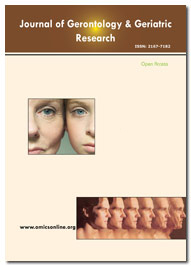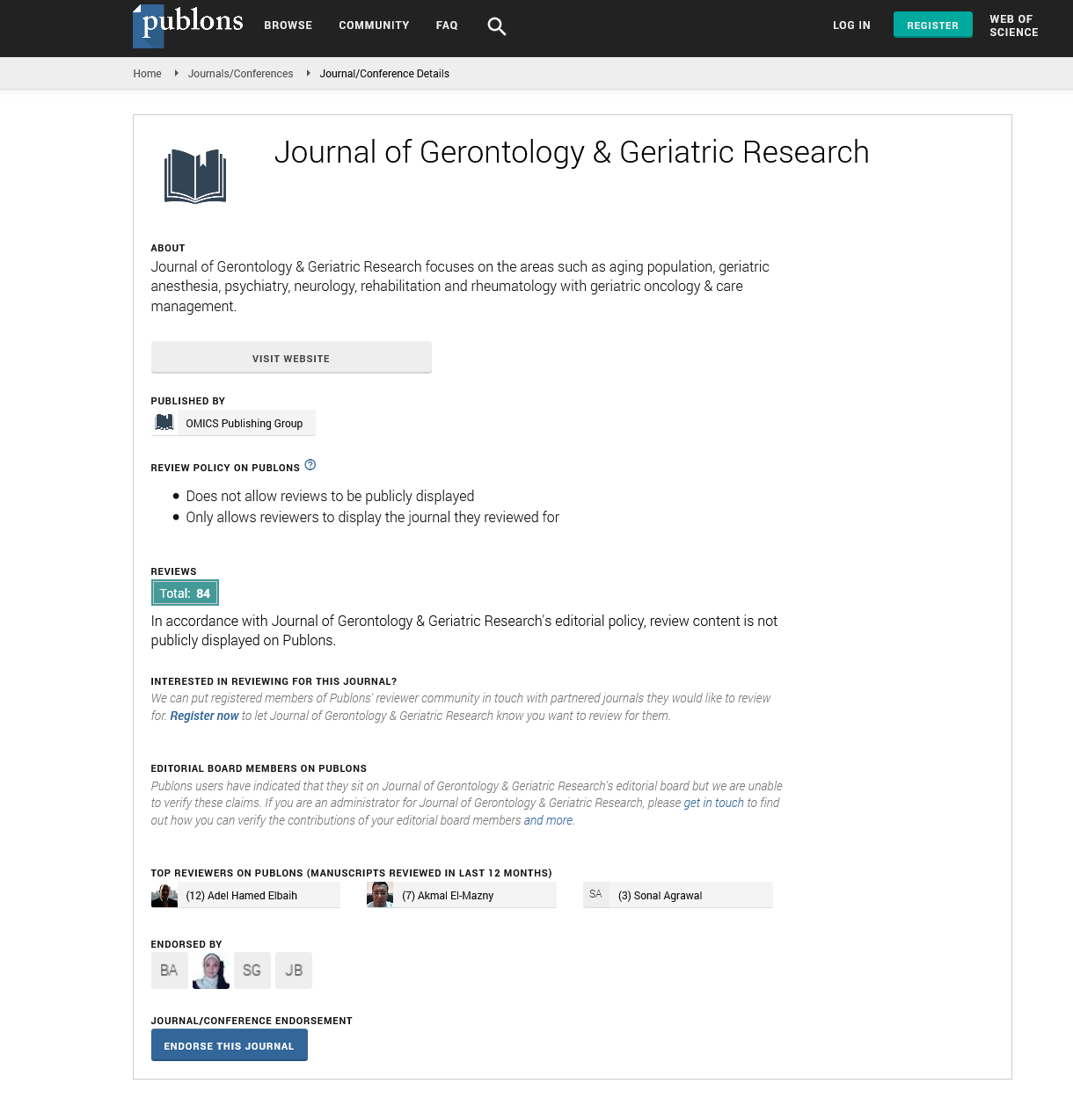Indexed In
- Open J Gate
- Genamics JournalSeek
- SafetyLit
- RefSeek
- Hamdard University
- EBSCO A-Z
- OCLC- WorldCat
- Publons
- Geneva Foundation for Medical Education and Research
- Euro Pub
- Google Scholar
Useful Links
Share This Page
Journal Flyer

Open Access Journals
- Agri and Aquaculture
- Biochemistry
- Bioinformatics & Systems Biology
- Business & Management
- Chemistry
- Clinical Sciences
- Engineering
- Food & Nutrition
- General Science
- Genetics & Molecular Biology
- Immunology & Microbiology
- Medical Sciences
- Neuroscience & Psychology
- Nursing & Health Care
- Pharmaceutical Sciences
Mini Review - (2022) Volume 11, Issue 6
The impact of a geriatric prescribing context
Brian T. Young*Received: 02-Jun-2022, Manuscript No. JGGR-22-18145; Editor assigned: 04-Jun-2022, Pre QC No. P-18145; Reviewed: 14-Jun-2022, QC No. Q-18145; Revised: 20-Jun-2022, Manuscript No. R-18145; Published: 25-Jun-2022, DOI: 10.35248/2167-7182.2022.11.620
Introduction
Caregiving for an elderly person must include optimising pharmacological therapy. The complex process of writing a prescription for a drug involves making the decision that a drug is necessary, selecting the best medication, figuring out a dose and schedule that are suitable for the patient's physiologic condition, checking for effectiveness and toxicity, warning the patient about potential side effects, and deciding when to consult a doctor. The severe effects of incorrect drug prescribing are known as avoidable adverse drug events (ADEs). When assessing an older adult, the likelihood of an ADE should always be kept in mind; any new symptom should be assumed to be drug-related unless disproven differently. There are particular difficulties when prescribing for elderly individuals. Older people are frequently excluded from premarketing medication trials, and approved doses may not be suitable for them [1].
The appropriateness and general quality of medicine prescription are influenced by a number of factors. These include avoiding unneeded prescriptions, using prescribed medications as prescribed, monitoring drug levels and side effects, avoiding drugdrug combinations, including the patient, and incorporating their values. One or a few of these criteria are frequently the focus of measures of the quality of prescription, but not all of them. Furthermore, it is unknown how well these indicators of "quality of prescribing" predict significant long-term medical consequences. Educational interventions, peer comparison feedback, automated order input and decision help, multidisciplinary team care under the direction of physicians, clinical pharmacists, and combinations of these approaches are strategies to reduce inappropriate prescribing in older individuals [2].
Description
In order to pinpoint times where process averages most likely occurred, researchers looked at specific cause signals. They then used binomial proportion tests to evaluate any possible shifts. According to the findings, no unique reasons were found during the testing period of any medicine. The control charts showed three distinct performance patterns following a notable initial improvement in 2017. Eight drugs kept the first improvement, and one medication afterwards displayed a second large improvement.
For 2 drugs, a later drop in performance was noted, although it wasn't statistically different from the initial decline [3].
The data that are currently available for these strategies generally demonstrate large reductions in incorrect prescribing but conflicting findings for costs or health outcomes. There was no impact of the interventions on hospital admissions, adverse drug events (ADEs), or mortality, according to a 2016 systematic review of eight studies examining various prescribing interventions in the long-term care setting (medication review, case conferences, staff education, clinical decision support technology, and/or some combination of these). An earlier 2008 systematic review of 10 studies of computerised physician order entry and clinical decision support in the hospital and ambulatory setting revealed a mixed impact on ADE reduction, with five studies demonstrating a statistically significant reduction in ADEs, four demonstrating a no significant decrease, and one study demonstrating no impact on rate of ADEs [4].
All drugs' reimplementation phases showed no unusual reasons. 2017 saw a strong early improvement, and control charts showed three distinct performance patterns. One medicine later showed a second major improvement, whereas eight medications kept the previous improvement. Two drugs demonstrated a subsequent performance drop that was not statistically different from the initial performance. Overall, after 42 months, eight of the 10 drugs were provided at doses and frequency that were more ageappropriate [5].
Conclusion
While it is admirable that people are living longer, it is also well known that getting older increases the burden of co-morbidity and, thus, the need for medication. In most industrialised countries, older people are the biggest consumers of healthcare resources, making appropriate selection and prescription of curative and preventative medications crucial. Even though just one in eight Americans is over 65, this small fraction of the population uses the most prescription drugs. The same is true for Europe, where older people use more than twice as much healthcare funding as younger people. Over 65s make up about one fifth of the population in the UK, however they only receive 45% of all healthcare services.
REFERENCES
- Charlson M. “Validation of a combined comorbidity index.” J Clin Epidem. 1994;47: 1245-1251.
- Colombo M. “The impact of cognitive impairment on the rehabilitation process in geriatrics.” Arch Geront Geriat. 2004;38: 85-92.
- Onoue H. “Trends in polypharmacy in Japan: a nationwide retrospective study.” J Amer Geriat Soci. 2018; 66: 2267-2273.
- Qato DM. “Changes in prescription and over-the-counter medication and dietary supplement use among older adults in the United States, 2005 vs. 2011.” JAMA Inter Med. 2016;176: 473-482.
- Marcum ZA. “Prevalence of unplanned hospitalizations caused by adverse drug reactions in older veterans.” J Amer Geriat Soc. 2012;60:34-41.
Google Scholar, Crossref, Indexed at
Google Scholar, Crossref, Indexed at
Google Scholar, Crossref, Indexed at
Google Scholar, Crossref, Indexed at
Citation: Young BT (2022) The Impact of a Geriatric Prescribing Context. J Gerontol Geriatr Res. 11: 620.
Copyright: © 2022 Young BT. This is an open-access article distributed under the terms of the Creative Commons Attribution License, which permits unrestricted use, distribution, and reproduction in any medium, provided the original author and source are credited.

